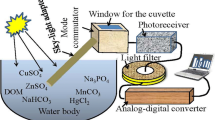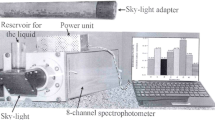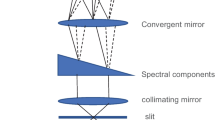Abstract
The geo-ecosystems of the lakes play an important role in their wider geographical areas, such as energy and biological resources, as well as water sources for agriculture, industry, and drinking water. The main goal of the present paper is to develop a new approach to the effective monitoring of lakes water quality. Three new optical decision-making systems (ODMS) are being set up first as components of this new monitoring system. The first ODMS is based on an 8-channel universal spectrophotometer. The second involves a 35-channel spectrophotometer to diagnose water sampling and the third includes a 128-channel spectroellipsometer. All versions of ODMS include special software that incorporates algorithms and models to solve optical inverse tasks and decision making about the quality of lakes water. ODMS provides a spectral image of the water quality of the lakes in wavelengths ranging between 350 and 910 nm depending on the optical device. The recognition of spectral images generated by ODMS allows the detection of adverse changes in water quality and the decision-making on the choice of strategy to deal with this change. In particular, a case study of Lake Sevan in Armenia is being conducted for the ODMS demonstration, and the results of the lakes water diagnosis are being discussed. The ODMS estimate for water quality error does not exceed 18%, while the forecast for water quality for 1 month includes an error not exceeding 10% and 20% for 1 year.









Similar content being viewed by others
References
Asatryan, V., & Dallakyan, M. (2015). The comparative assessment of rivers impact on Lake Sevan’s (Armenia) water quality by hydrochemical parameters. In Proc. of Int. Science-Practical Conf., 29-31 May 2015 (pp. 1–6). Perm.
Avalyan, R. E., Aghajanyan, E. A., Khosrovyan, A., Atoyants, A. L., & Simonyan, A. E. (2017). Assessment of mutagenicity of water from Lake Sevan, Armenia with application of Tradescantia (clone 02). Mutation Research, 800, 8–13.
Babayan, A., Hakobyan S., Jenderedjian K., Muradyan S., Voskanov M. (2006). Lake Sevan experience and lessons learned brief. Experience and Lessons Learned Brief, 347-362, http://www.worldlakes.org/uploads/21_Lake_Sevan_27February2006.pdf
Cracknell, A. P., & Varotsos, C. A. (2007). Editorial and cover: Fifty years after the first artificial satellite: from sputnik 1 to envisat. International Journal of Remote Sensing, 28(10), 2071–2072.
Cracknell, A. P., & Varotsos, C. A. (2011). New aspects of global climate-dynamics research and remote sensing. International Journal of Remote Sensing, 32(3), 579–600.
Danielian, C. (2011). GEO – Lake Sevan: integral evaluation of the Lake Sevan ecological state (p. 42). Erevan: UNEP GROD-Arendal.
Danielyan, K. (Ed.). (2003). National report on the state of the environment in Armenia in 2002 (p. 130). Yerevan: Ministry of Nature Protection of the Republic of Armenia.
Davidov, V. K. (1938). Water balance of Lake Sevan (p. 82). Moskow: Hydrometeoizdat [in Russian].
Efstathiou, M. N., & Varotsos, C. A. (2010). On the altitude dependence of the temperature scaling behaviour at the global troposphere. International Journal of Remote Sensing, 31(2), 343–349.
Gevorgyan, G. A., Mamyan, A. S., Hambaryan, L. R., Khudaverdyan, S. K., & Vaseashta, A. (2016). Environmental risk assessment of heavy metal pollution in Armenian river ecosystems: case study of Lake Sevan and Debed River catchment basins. Polish Journal of Environmental Studies, 25(6), 2387–2399.
Gluskov, V. G., & Davydov, V. K. (Eds.). (1932). On the investigation of Lake Sevan and its basin (85 pp). Leningrad: The Sevan Hydro-Meteorological Bureau.
Hao, P. M., Man, N. X., Van Thao, N., Krapivin V.F., Mkrthyan F.A., Klimov V.V. (2019). Capabilities an adaptive spectroellipsometric and spectrophotometric technologies for monitoring aquatic systems in Vietnam. Proceedings of Int. Symposium on the Engineering Ecology, 3–5 December 2019, Moscow, vol. X, pp. 150–154.
Hewson, E. W., & Olsson, L. E. (1967). Lake effects on air pollution dispersion. Journal of the Air Pollution Control Association, 17(11), 757–761. https://doi.org/10.1080/00022470.1967.10469069.
Hovsepyan, A. A., Khachikyan, T. G., & Hambaryan, L. R. (2014). Influence of Lake Sevan catchment basin phytoplankton community structure on the same of the lake. In H.-S. Shin & M. Naebandyan (Eds.), Sustainable Management of Water Resources and Convertation of Mountain Lake Ecosystem of Asian Countries (pp. 102–112). Yereva: The Association of Academies and Societis of Sciences in Asia.
Hovsepyan, A., Tepanosyan, G., Muradyan, V., Asmaryan, S., Medvedev, A., & Koshkarev, A. (2019a). Lake Sevan shoreline change assessment using multi-temporal Landsat images. Geography Environment Sustainability, 12(4), 212–229.
Hovsepyan, A. A., Mamyan, A. S., Khachikyan, T. G., Tikhonova, I. V., Sorokovikova, E. G., Belykh, O. I., & Gevorgyan, G. A. (2019b). Monitoring of phytoplankton status in Lake Sevan 2018. Proceedings of the Yerevan State University: Chemistry and Biology, 53(3), 206–211.
Jones, B. A., & Fleck, J. (2020). Shrinking lakes, air pollution, and human health: evidence from California’s Salton Sea. Science of the Total Environment, 712, 136490.
Kachvoryan, E. A., Pepoyan, A. Z., Harutyunova, M. V., & Manvelyan, A. (2008). Ecosystems of Lake Sevan Basin’s rivers in Armenia. World Academy of Science, Engineering and Technology, 2, 442–445.
Krapivin, V.F., Soldatov, V. Y. (2018). Simulation model of pollutant spreading in the Arctic Basin ecosystem. Proceedings of the 33rd International Symposium on Okhotsk Sea & Polar Oceans 2018. 18–21 February 2018. Mombetsu, Hokkaido, Japan. Okhotsk Sea and Polar Oceans Research Association, Mombetsu, Hokkaido, Japan, 2018, pp. 361–364.
Krapivin, V. F., Varotsos, C. A., & Soldatov, V. Y. (2015). New ecoinformatics tools in environmental science (903 pp). London: Springer.
Krapivin, V. F., Varotsos, C. A., & Christodoulakis, J. (2016). Mission to Mars: adaptive identifier for the solution of inverse optical metrology tasks. An International Journal of Solar System Science: Earth, Moon, and Planets, 4, 1–14.
Krapivin, V. F., Varotsos, C. A., & Nghia, B. Q. (2017a). A modeling system for monitoring water quality in lagoons. Water, Air, and Soil Pollution, 228(397), 1–12.
Krapivin, V. F., Varotsos, C. A., & Soldatov, V. Y. (2017b). The Earth’s population can reach 14 billion in the 23rd century without significant adverse effects on survivability. International Journal of Environmental Research and Public Health, 14(8), 3–18.
Krapivin, V. F., Nitu, C., Mkrtchyan, F. A., Soldatov, V. Y., & Dobrescu, A. S. (2018). Information-instrumental tools of microwave and optical environmental monitoring. The Scientific Bulletin of Electrical Engineering Faculty, 18(1), 11–18.
Margaryan, V., Tsibul’skii, G., Raevich, K. (2020). Dynamics of changes in long-term average annual river runoff in the Lake Sevan Basin. E3S web Conf., 149, 03009: 1-6.
Matishov, G. G., Selyutin, V. V., Mesropyan, K. E., Bulysheva, N. I., Sheverdyaev, I. V., Aroutiounian, R. M., & Gabrielyan, B. K. (2016). Current state and problems of the study of Lake Sevan. Science in the South of Russia, 12(2), 43–52.
Meybeck M., Akopian M., Andréassian V. (1997) What happened to Lake Sevant? / SILnews 23. https://limnology.org/what-happened-to-lake-sevant-silnews-23/
Mkrtchyan, F. A., Krapivin, V. F., & Klimov, V. V. (2019). An adaptive optical technology for monitoring marine ecosystems. In Proceedings of the 34th International Symposium on Okhotsk Sea & Polar Oceans 17–20 February 2019 (pp. 414–417). Mombetsu.
Nitu C., Krapivin V.F., Mkrtchyan F.A., Soldatov V.Yu. Dumitrascu A. (2019). Information-modeling instrumental system for the water resource diagnostics. Proceedings of the 22nd International Conference on Control Systems and Computer Science (CSCS), May 29–31, 2019, Bucharest, Romania, pp. 471–477.
Oganesian, R. O., Ostrovsky, I. S., Manoukian, G. M. (1986). Bioindicators of water quality of rivers of the Lake Sevan basin: Gavaraget River as a case study. Conference: Nature, town, Man, the all-Armenian Foundation “Ayastan”, pp. 133-135; https://www.researchgate.net › publication › 236620294_Bioindicators_of_.
Ostrovsky, I. S. (1986). Bioindicators of water quality of the Lake Sevan Basin: Gavaraget River as a case study. PhD Dissertation, Institute of Zoology, Leningrad, 150 pp.
Pavlov, D. S., Poddubnij, S. A., Gabrielyan, B. K., & Krilov, A. V. (2010). Ecology of Lake Sevan during the period of water level rise (p. 348). Machachkala: Science Publ [in Russian].
Pepoyan, A. Z., & Manvelyan, A. (2008). Ecosystems of Lake Sevan Basin’s rivers in Armenia. World Academy of Science, Engineering and Technology, 2, 442–446.
Petrosyan, V., Pirumyan, G., & Perikhanyan, Y. (2019). Determination of heavy metal background concentration in bottom sediment and risk assessment of sediment pollution by heavy metals in Hrazdan River (Armenia). Applied Water Science, 9(102), 1–9.
Sargsyan, V. A. (2000). Risk assessment for agricultural pollutants (Armenia). In I. Linkov & Palma-Oliveira (Eds.), Modelling and optimal control assessment and management of environmental risk, Cost-efficient Methods and Applications (pp. 275–282). Dordrecht: Kluwer Academic Publishers.
Sargsyan, V. A. (2005). Lake Sevan in Armenia. Socioeconomic analysis for secure development policies. In I. Linkov, G. A. Kiker, & R. J. Wenning (Eds.), Environmental security in harbors and coastal areas (pp. 439–450). Dordrecht: Springer.
Sargsyan, V. A. (2007). Lake Sevan in Armenia. In I. Linkov, G. A. Kiker, & P. J. Wenning (Eds.), Environmental Security in Harbors and Coastal Areas. NATO Security through Science Series (Series C: Environmental Security) (pp. 439–449). Dordrecht: Springer.
Shin, H.-S., & Nalbandyan, M. (Eds.). (2014). Sustainable management of water resources and conservation of mountain lake ecosystems of Asian countries (pp. 102–112). Yerevan: The Association of Academies and Societies of Sciences in Asia.
Vardanian, T. (2009). The hydrochemical changes of Lake Sevan water after the artificial lowering of the water level. In A. M. Bahadir & G. Duca (Eds.), The Role of Ecological Chemistry in Pollution Research and Sustainable Development. NATO Science for Peace and Security Series C: Environmental Security (pp. 77–84). Dordrecht: Springer.
Vardanian, T. (2012). On some issues of the anthropogenic transformation of water ecosystems (case study of Lake Sevan). NATO Science for Peace and Security Series C: Environmental Security, 125, 325–336.
Vardanyan, L., Azizyan, L., Yeroyan, Y., & Danielyan, A. (2014). The change of water resources in Lake Sevan in the context of climate change renewed scenarios. In H.-S. Shin & M. Naebandyan (Eds.), Sustainable Management of Water Resources and Convertation of Mountain Lake Ecosystem of Asian Countries (pp. 123–128). Yerevan: The Association of Academies and Societis of Sciences in Asia.
Varotsos, C., & Cartalis, C. (1991). Re-evaluation of surface ozone over Athens, Greece, for the period 1901–1940. Atmospheric Research, 26(4), 303–310.
Varotsos, C. A., & Krapivin, V. F. (2017). A new big data approach based on geoecological information-modeling system. Big Earth Data, 1(1–2), 47–63.
Varotsos, C. A., & Krapivin, V. F. (2018). Pollution of Arctic waters has reached a critical point: An innovative approach to this problem. Water, Air, & Soil Pollution, 229(11), 343, 1-14.
Varotsos, C. A., & Krapivin, V. F. (2019). Modeling the state of marine ecosystems: a case study of the Okhotsk Sea. Journal of Marine Systems, 194, 1–10.
Varotsos, C. A., Efstathiou, M. N., & Cracknell, A. P. (2013). On the scaling effect in global surface air temperature anomalies. Atmospheric Chemistry and Physics, 13(10).
Varotsos, C. A., Krapivin, V. F., & Soldatov, V. Y. U. (2019). Arctic latitudes environmental pollution effects. In Proceedings of the 34th International Symposium on Okhotsk Sea & Polar Oceans, 17–20 February 2019, Mombetsu (pp. 418–421). Mombetsu: Okhotsk Sea and Polar Oceans Research Association.
Varotsos, C. A., Krapivin, V. F., & Soldatov, V. Y. (2019a). Monitoring and forecasting of tropical cyclones: a new information-modeling tool to reduce the risk. International Journal of Disaster Risk Reduction, 36, 1–7.
Varotsos, C. A., Krapivin, V. F., & Mkrtchyan, F. A. (2019c). New optical tools for water quality diagnostics. Water, Air, and Soil Pollution, 230(8), 177, 1-12.
Wang, H., Laplante, B., Wu, X., & Meisner, C. (2004). Estimating willingness-to-pay with random valuation models: an application to Lake Sevan (p. 41). Policy Research Working Paper, WPS33672004.
Yu, W., Cestti, R. E., & Lee, J. Y. (2015). Toward integrated water resources management in Armenia (160 pp). Washington: The World Bank.
Author information
Authors and Affiliations
Corresponding author
Additional information
Publisher’s Note
Springer Nature remains neutral with regard to jurisdictional claims in published maps and institutional affiliations.
Rights and permissions
About this article
Cite this article
Varotsos, C.A., Krapivin, V.F., Mkrtchyan, F.A. et al. A Novel Approach to Monitoring the Quality of Lakes Water by Optical and Modeling Tools: Lake Sevan as a Case Study. Water Air Soil Pollut 231, 435 (2020). https://doi.org/10.1007/s11270-020-04792-8
Received:
Accepted:
Published:
DOI: https://doi.org/10.1007/s11270-020-04792-8




